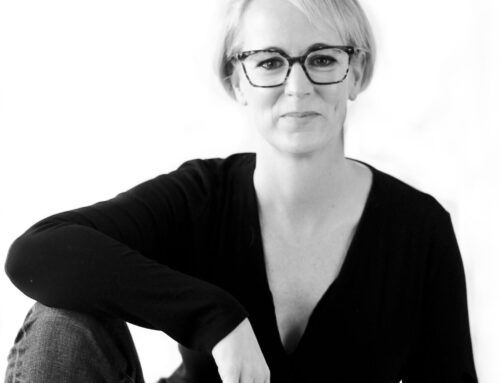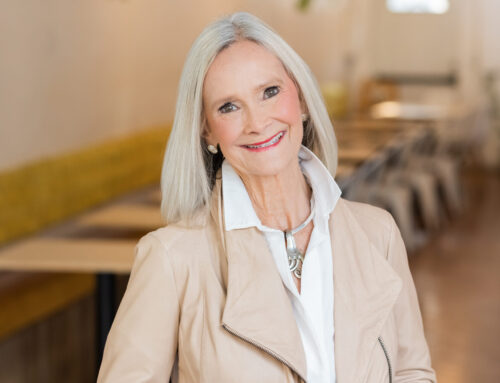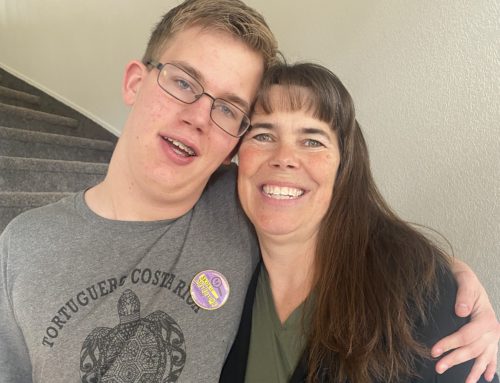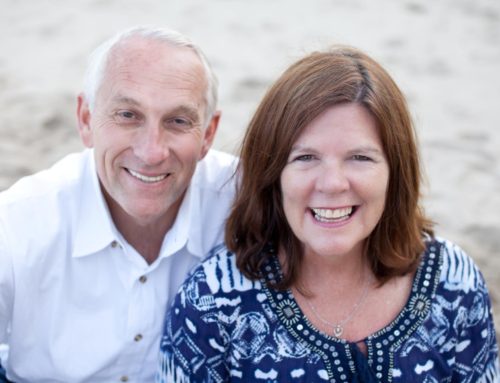By Leslie Graff, as told to Whitney Archibald
I never intended to be an artist. But shortly after moving to Virginia and having my first child, I decided we needed something on the walls of our new home. I figured it would be cheaper for me to paint something than to buy something. So I pulled out my paints from high school and painted a few things.
Then we moved again, to Massachusetts, and I started painting for those new walls. One day, a woman came over to our house and she saw one of them. She said, “I love this painting. Where did you get it? Can I buy it?”
I was surprised, but said, “Sure!”
Then she said, “Actually, I have a gallery. Would you do a show?”
I agreed to do the show, just for the sake of my own personal development. So I painted a lot of paintings, which was really good for me. I’d pull out my paints at nap time, paint for an hour at the kitchen table, and then clean it all up again.
I went into the show thinking that If someone bought one piece I was going to feel super special. I thought, “Who buys art?” Then I ended up selling half the show. It just kept going and going. I always felt imposter syndrome, but I kept painting.
If someone had told me when I was in college that my paintings would one day be hanging in art galleries, I wouldn’t have believed it. Now I can’t imagine not painting. It has enriched my life and my family so much. My art is now hanging on other people’s walls as well as my own, and in several galleries and museums. I really feel that the only way I have been able to turn my art into a career is because I’ve done it on my own terms, on my own path.
Making Time
I took a few art classes in high school, and painted for fun, but I didn’t study art in college. I got my master’s degree in family and human development, and got married soon after graduate school. We moved to California, where I worked as a child life specialist at the University of California San Francisco and taught childhood development at Ohlone College. After being married for about a year, I got pregnant with my first son and we moved to Virginia.
“All Clean”
I loved the work I was doing in California, but when we moved, it just felt like the right time to stop working. I wanted to focus on having my baby and then stay home with him. I have always been the type that wanted to do things on my timetable.
Once I started to paint, I confined it to naptime, or when my kids went to sleep at night, because I couldn’t be emotionally present with my kids and painting well at the same time. I knew that and chose that.
A lot of people said, “You can paint while your kids are playing in the room.” But I wanted to be active with them, and tending to three kids is a lot of work. So I just chose to segregate my parenting and my art. Then when I was creating it was really peaceful and really focused. I really enjoyed that.
“Welcome Home”
I didn’t paint during the day at all until my youngest started kindergarten. Then I suddenly had more time. Even now that my sons are 17, 13, and 10, I don’t spend all the time they’re in school in my studio. I also like to fit in going to the grocery store and other things, because I don’t like those other things to pile up into the times when my kids are home.
I really think the reason I’ve been able to have a career as an artist is that the art has always been on my terms and on my time. Setting my own boundaries has let me create work that’s meaningful to me. I produce much better art if I’m not feeling guilty or upset. I work more efficiently. I’m on my game.
Discovering My Own Path
Sometimes we get kind of railroaded into thinking in a very linear way: “I ultimately want to do this, so I have to do this right now.” Especially for women, that’s just not true. There’s lots of different ways to get to success, lots of timelines, lots of paths, and it’s not always a direct one or the traditional one that leads to success. I’ve always argued for that.
“Her Piece of the Pie”
When you’re happy and feel in control of your life, when you’re not sacrificing to a degree that you feel uncomfortable with, when you’re doing things you really love, you do better. If the path you’ve chosen is causing too much sacrifice, it’s ok to say, “Not this. Not right now.” That’s always my approach.
I had a friend who finished her PhD and was trying to decide between writing and a tenure-track faculty position. She had just had a baby. The position was something she wanted eventually, but not necessarily right then. She worried that if she didn’t take the position right then, she might never get it.
Everyone said, “Just take it. This is your dream.” But I said, “If this isn’t what you want for the next 10 years, don’t give up the next 10 years for what you think you want 10 years from now. Who knows what you’ll want in 10 years. That same position may come up then, too.”
“438 Volumes”
If we are more deliberate and willing to set our own boundaries, the world often flexes around those boundaries. We don’t have to play the same game as everyone else to be successful. You can do it on your own time and in your own way. And that doesn’t necessarily preclude success or opportunities.
There’s always more we could be doing. Sometimes I think I should probably be marketing my art more and chasing more opportunities, but I just don’t. My life is busy enough. I’ve got enough going on. There’s pressure to do that, but that’s not what I want to do and it’s OK. And then opportunities happen and it all works out.
I can’t even imagine being at this point if I’d gone into only art. I don’t know if I could have achieved what I have if I had gone down a traditional path. Amazing things can happen when you trust the way you feel about things and go with that.
Creating Good Out of Grief
Shortly after I began painting again, I had seven miscarriages in three years. I would get 10 to 11 weeks in and then I would lose the pregnancy. I just couldn’t figure out why it was happening. Ultimately I discovered that I had heritable thrombophilia.
I really struggled with how to memorialize that many losses. With my background as a child life specialist, I really tried to figure out a tangible way to work through my experience. I decided, “What if I develop a talent to honor that chapter of my life?”
“Nocturne for Loneliness”
So I started to paint more. It was really emotional and difficult. It wasn’t like I was painting therapeutically, but I was painting to have a therapeutic end, which was to create more good things out of grief—to allow an experience that was really challenging to bring something really good into my life.
The first show I did was two weeks after my second miscarriage. That was my hardest one. I was 12 weeks along. I was going to tell everyone I was pregnant at the opening and I wasn’t, so there was a lot on my mind.
Pregnancy loss can be a very unique, silent kind of grief. You’re the only one who really experienced it, nobody knows about it, and it’s almost like it gets quieter and quieter. But the more I created art, the more that experience expanded rather than contracted. There’s a really good influence that comes from creating more beautiful things and inspiring other people to create. Even from an economic perspective, the more paintings I sell, the more good things I can do in the world with that.
Communicating Through Art
When I first started painting, my work was more impressionistic—flowers, fruit, landscapes. I wasn’t trying to say anything with my art. You start painting because you like painting, and then you find your voice, and find your style, and find the way you see and interpret the world, and then express that in your work.
I love for my work to be open-ended enough that people can connect with it and find meaning in the metaphor, so it can have more depth. There’s a lot of meaning in mundane objects and tasks.
Do You Want to Fast Forward, Rewind, or Eject?
For example, lately I’ve been painting a series of nostalgic artifacts, such as telephones, mix tapes, and cameras, in a series I call “Rewind.” I have done several paintings of mix tapes because there’s this existential feeling behind them. They’re usually titled: “Do you want to fast forward, rewind, or eject.” Everyone in the world has felt these things at some point in their lives. Sometimes you want to just hurry up and get to the next point in your life, or you want to go back and do something over again, or you just want out. I love exploring that metaphor. These tangible artifacts mark a certain time in your life. I love them. They’re so much fun to make.
The Domestic Series
Probably the most open-ended and thought-provoking series I have created is my Domestic Series. The idea came when I was sweeping in the kitchen, wearing an apron that was made by my great-grandmother. I inherited several of the aprons she embroidered. I thought, “I bet she wore this apron to sweep her kitchen. Here we are decades and generations apart and here I am doing the same task she did.” I realized this would make an interesting painting. But even more interesting, if I cropped the face you wouldn’t necessarily know who it was or when it was, because the apron was the same.
I started writing more ideas in a notebook. I thought I’d do four or five. My friend came over and told me I really needed to develop the series. She made me promise I’d paint at least ten before selling any, to keep them as a series.
Ten paintings turned into thirty—twenty that were just women and ten that were specifically mothering, and I wouldn’t sell any of the pieces in the series until I finished all 30 and could show them together. Then I took a break for two years, and now I create a few pieces in that series now and then. I’ve probably done over 50. It’s turned into a much bigger series than I ever expected it to be.
“Her Call”
My titles and the tasks the person is doing are often a metaphor for another emotional experience. For example, I often use telephones. I like them because they represent an emotional presence. I grew up in an era where if you missed a call, you missed it. It was a horrible feeling: “What if I missed it?” It relates so much to parenting. You don’t want to be like, “Oh no, I missed that!” We’re either present or we’re not.
“Stirring Things Up”
A lot of my paintings involve food. One of my favorites is called “Stirring Things Up.” It’s one of the first four that I did in the series. I wanted to communicate that sometimes you have to agitate and even be a little disruptive to make things what you want them to be and let your voice be heard in the world. I’m really passionate about what I believe.
It’s been interesting to show this series in galleries and see the reaction and the dialogue omes out of them. Given my background in family and human development it’s been really interesting to talk about how we view families, how our roles change and shift, and how we view women now as opposed to 20 or 40 years ago. It’s interesting to talk about “what is home,” and really ask questions and explore that experience.
They raise a lot of questions about where we come from, where we’re going, what we’re retaining, what we’re giving up. Now that women have so many options and opportunities available to us, what is the place of domestic things. Where do they fit in? What happens if we outsource all of those things? Do we lose connection? Do we lose a different perspective on roles? Is mothering more about the relationship we have with our children, or is it a collection of those tasks that we do to take care of them?
“Sparkly Clean”
I really want to honor women’s experience in the past. We wouldn’t be anywhere without the investments and work that women did before us. That work got us to where we are, and we continue to get people to that next step. We’re constanly tryng to evolve, but we have to honor what they did before. How can I look back on what my grandmother or great grandmother did and say, “I can’t believe you just spent the whole day doing that.” I could never feel that. I want to honor and respect the fact that that was their lives, by choice or not. That was the opportunity and option that was available to them.
I like that every woman brings her own experience to my work. Some women look at it and say, “This looks like me, because I come home from work and I don’t even have time to change and I’m fixing dinner for my kids.” They can see some aspect of themselves or someone they know. Someone will say, “Looking at that makes doing my laundry seem so much more important than what I feel when I’m actually doing my laundry.” It feels important and feels powerful.
My Art and My Family
I’m constantly amazed at how much the work I’ve done has enriched and benefitted my family. My kids and I talk all the time about why I create the kind of art that I do and what it says and why I’m passionate about different things.
I love art because of the way it teaches you how to think. Art teaches you to be so flexible. It teaches you that you can start over. You can always get a new piece of paper. You can come back to things. You can change it and alter it, and ending points are not finite. That philosophy of art is very much the philosophy of our home. I teach them to attaching meaning to things in their lives and to be deliberate about how they do things.
“Her Mind Was Hot”
My art career has created so many rich experiences for my sons. They go to my openings at museums and they talk to curators. Working as my art assistant helped my oldest son develop a sense of aesthetics and composition and color, not to mention his own portfolio of work. He’s taking that with him to college next year, to study industrial design. In a very practical sense, if he hadn’t had this environment or experience, he wouldn’t be in the place he is in terms of his own professional experience.
Perhaps more importantly, my sons see me as a woman, not just a caretaker. They know that I’m intelligent and capable and could work as much as I wanted to, but that I still choose to fold their laundry and make them that crazy birthday cake they want. That’s really empowering. My mom had a masters degree in nursing, but she always stayed home with us and taught a few classes on the side. I always knew I was super important because she was giving up a lot to choose to stay home with us.
Giving Back
I’ve always been a big believer in being involved in the community and being civically minded. I think God gives us all talents, opportunities and abilities so we can be really useful. We become specialized tools. Everyone has different talents and abilities that we use to provide different skills or services in interesting ways. I love it when you find that fit, when your talents and abilities are exactly what someone needs.
So with my background as a child life specialist I started doing medical missions with Operation Smile. While they do cleft lip and palate surgery, I run the playroom, I do the psychological preparation for the patient for the procedure and make sure the psycho-emotional needs are being met.
When my second son was born he had a small port-wine stain and that got me involved with the Vascular Birthmarks Foundation. I became their psychosocial and developmental specialist, because I realized that a lot of families were struggling with not just the medical aspect of dealing with a child who might have a visible difference, but also the emotional and social aspects. I offered to talk to families who were struggling, and they asked me to present at a conference. The I presented at the next 11 conferences. I even joined their international team to present to physicians about vascular anomalies around the world, from Italy to India.
I also sit on the cultural arts council in our town, and on the national advisory board for Brigham Young University for family and social sciences. I love sharing my opinions and trying to come up with solutions.
All of the different experiences and educational opportunities I’ve had have lined up perfectly with service I can do in the community. It’s really fulfilling when you can take a talent or skill that you have and use it in the community to do good. There are so many people out there with so many skills. If we each go out there and do a few little things, what a difference we can make.
The way I judge the success of a day is whether I have helped someone else or whether I have become better in some way. When you find those things, you feel better about yourself. It’s a perpetual cycle that keeps going and yields amazing results. You can see you’re making a difference in the lives of other people and creating something meaningful.
Leslie Graff (lesliegraff.com) is a mother of three boys, ages 17, 13, and 10. She holds Bachelors and Masters degrees from Brigham Young University. She spends her time working in acrylics and mixed media. Her work has been featured in books and magazines, including a profile on Forbes.com, a review in the Boston Globe, and NPR. Leslie is currently on the faculty at the Danforth Art Museum School. She is active in humanitarian work and is passionate about building opportunity for others.


















Leave A Comment